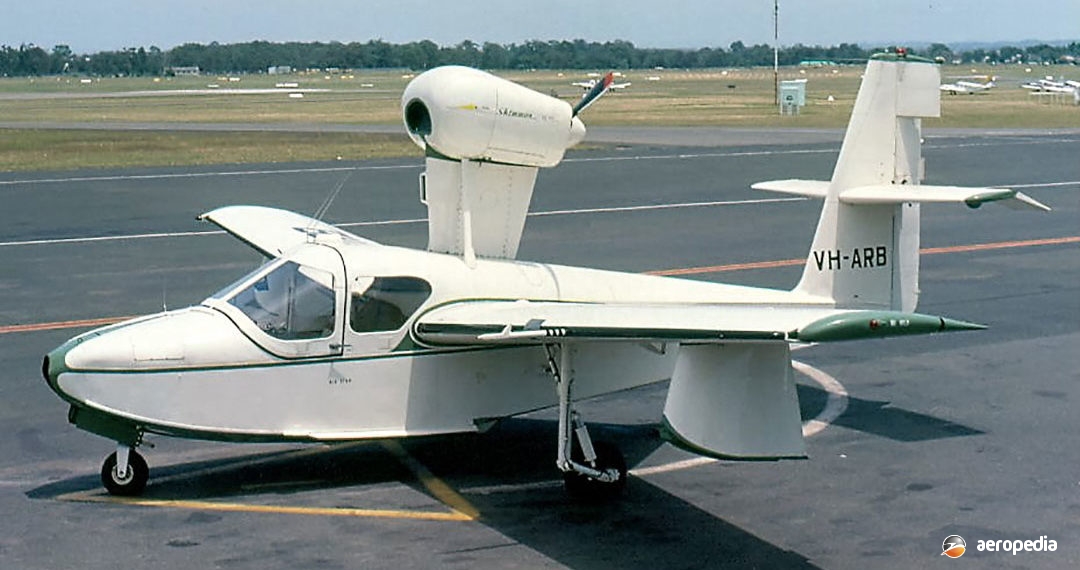Photograph:
Colonial C-2 Skimmer VH-ARB (c/n 133) at Bankstown, NSW in December 1978 (David C Eyre)
Country of origin:
United States of America
Description:
Light sport amphibious flying boat
Power Plant:
(C-1)
One 93 kw (125 hp) Lycoming O-290-D four-cylinder horizontally-opposed air-cooled engine
Specifications:
- Wingspan: 10.37 m (34 ft)
- Length: 7.16 m (23 ft 6 in)
- Height: 2.68 m (8 ft 10 in)
- Wing area: 14 m² (150.6 sq ft)
- Max speed: 200 km/h (125 mph)
- Cruising speed: 184 km/h (115 mph)
- Stalling speed: 74 km/h (46 mph)
- Initial rate of climb: 213 m/min (700 ft/min)
- Cruising range: 1,120 km (700 miles)
- Fuel capacity: 151 litres (33 Imp gals)
- Empty weight: 590 kg (1,300 lb)
- Disposable load: 295 kg (650 lb)
- Loaded weight: 885 kg (1,950 lb)
History:
The Colonial Skimmer was a successful foray into the production of an amphibian for private use by the Colonial Aircraft Corporation. In 1946 Herbert P Lindblad joined David B Thurston on the design of a light amphibian known as the Skimmer and the project was soon joined by other designers and engineers from Grumman and Republic. They all worked on the design part-time until March 1955. A production facility was set up in old woollen mills at Sanford, Maine.
The prototype of the series (N6595K), the C-1, flew for the first time on 17 July 1948 with an 86 kw (115 hp) Lycoming O-235C-1 engine mounted on a pylon on the rear top of the cabin. The Company was formed in December 1946 by the group of five engineers who at the time worked for Grumman Aircraft Corporation and Republic Aviation Corporation. Seating three, it was powered by a 93 kw (125 hp) Lycoming O-290-D four-cylinder engine, driving an Aeromatic propeller, type approval being granted by the US FAA on 19 September 1955.
Early trials revealed that more power was required and this led to the introduction of the Lycoming O-320-A1A engine of 112 kw (150 hp) driving a Hartzell propeller in the C-2 model. Later in 1957 after some improvements and development the 134 kw (180 hp) Lycoming O-360-A1A engine driving a Hartzell two-blade propeller was fitted and, seating four, this became known as the Skimmer IV. This model received certification on 24 December 1957.
The aircraft was produced for a few years up until 1959 when manufacturing rights were purchased by Jack Strayer and Lake Aircraft was formed to develop the design. A total of 24 examples of the C-1 series was completed with construction numbers 1 to 14, 16 to 20, and 22 to 25, certification being received in September 1955. Production then moved to the Model C-2 (also known as the Skimmer IV), which was fitted with a 134 kw (180 hp) Lycoming O-360 engine and three seats, some 199 examples being delivered with the construction numbers 115 and 126 to 243 for which certification was received in December 1957.
Only one example was imported to Australia, this being a C-2 Skimmer IV VH-ARB (c/n 133 – ex N275B) imported by Mervyn V Richardson, managing director of Victa Consolidated Industries of Milperra, NSW, the well known lawn-mower constructors, and builders of the successful Victa Airtourer. The Skimmer was registered in October 1959 and was used by him to fly from his home at Pittwater, on Sydneys northern beaches, where it was hangared, to Bankstown, NSW near the Company’s production facility. It was later sold to Mesh Air of Biloela, QLD which used it for charter work in south-east Queensland; and later to J R Marland of Avalon Beach, NSW. It was withdrawn from service and stored for some years but was returned to airworthiness in July 2007 when the registration was changed to VH-VRB registered to Goss Holdings of Balmain, NSW.

